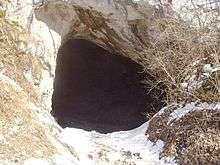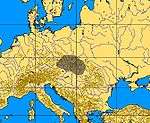Szeletian
The Szeleta Culture is a transitional archaeological culture between the Middle paleolithic and the Upper Palaeolithic, found in Austria, Moravia, northern Hungary, and southern Poland.[1] It is dated 41,000 to 37,000 years before the present (BP), and is named after the Szeleta cave in the Bükk Mountains, part of the North Hungarian Mountains.

It was preceded by the Bohunician (48,000–40,000 BP), and is roughly contemporary with the Aurignacian (43,000–26,000 BP) in France, and the Uluzzian (45,000–37,000 BP) in Italy. It was succeeded by the Gravettian (33,000–21,000 BP).
The initial excavation of the Szeletian cave was carried out 1906–1913 by Ottocar Kadić.[2] The idea of a distinctive Szeletian culture was advocated by the Czechoslovakian archaeologist Frantisek Prosek (1922-1958).[3]

Neanderthals or modern humans
It has been called the most original and also the most aboriginal Upper Palaeolithic culture in Central Europe. [4] The findings are often interpreted in terms of the contemporaneity of Neandertal and modern man, "as the product of acculturation at the boundary of Middle and Upper Paleolithic."[5] However, the absence of human remains makes it impossible to attribute the culture to Neanderthals or modern humans.
Lithic industry
The lithic industry is characterized by:
- bifacial foliated points and sidescrapers
- Prismatic and discoid debitage
- Presence of Micoquien hand axes
Later assemblages contain endscrapers and retouched blades. [3]
Sites
In addition to the Szeletian cave in Hungary, assemblages have been found in Dzierzyslaw and Lubotyń (Poland),[6] at Čertova pec in Slovakia, and Pod Hradem (Moravia).[3][7]
References
- Adams B., 1998: The Middle to Upper Paleolithic Transition in Central Europe: The Record from the Bükk Mountain Region. BAR International Series 693, Oxford. 175 pp.
- Kadic, Ottocar. Ergebnisse der Erforschung der Szeletahöhle. na, 1916.
- "Szeletian". Archaeology Wordsmith. Retrieved April 26, 2020.
- Oliva, Martin. "The Szeletian in Czechoslovakia." Antiquity 65, no. 247 (1991): 318-325.
- Allsworth-Jones, Philip, 2004. The Szeletian revisited. Anthropologie (1962-), 42(3), page 292.
- Połtowicz-Bobak, Marta; Bobak, Dariusz (2013). "Nouvelles données sur le Szélétien en Pologne". Repozytorium UR. Uniwersytet Rzeszowski. Retrieved April 26, 2020.
- Valoch, K. (1990). La Moravie il y a 10 000 ans. Actes du Colloque International de Nemours, 1988: Paléolithique moyen récent et Paléolithique supérieur ancien en Europe. Ruptures et transitions: examen critique des documents archéologiques, Mémoires du Musée de Préhistoire d'Ile de France, 3. Nemours: Ed. A.P.R.A.I.F. pp. 115–124, 4 fig.